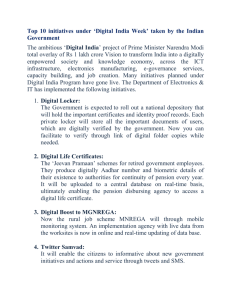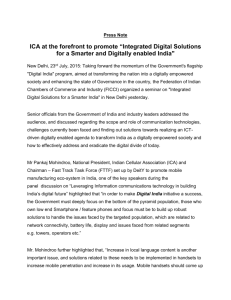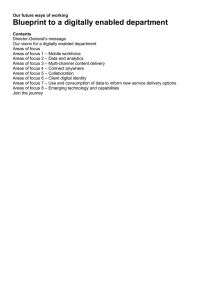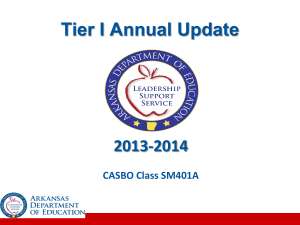5.11—Digital Learning Courses - Arkansas School Boards Association
advertisement
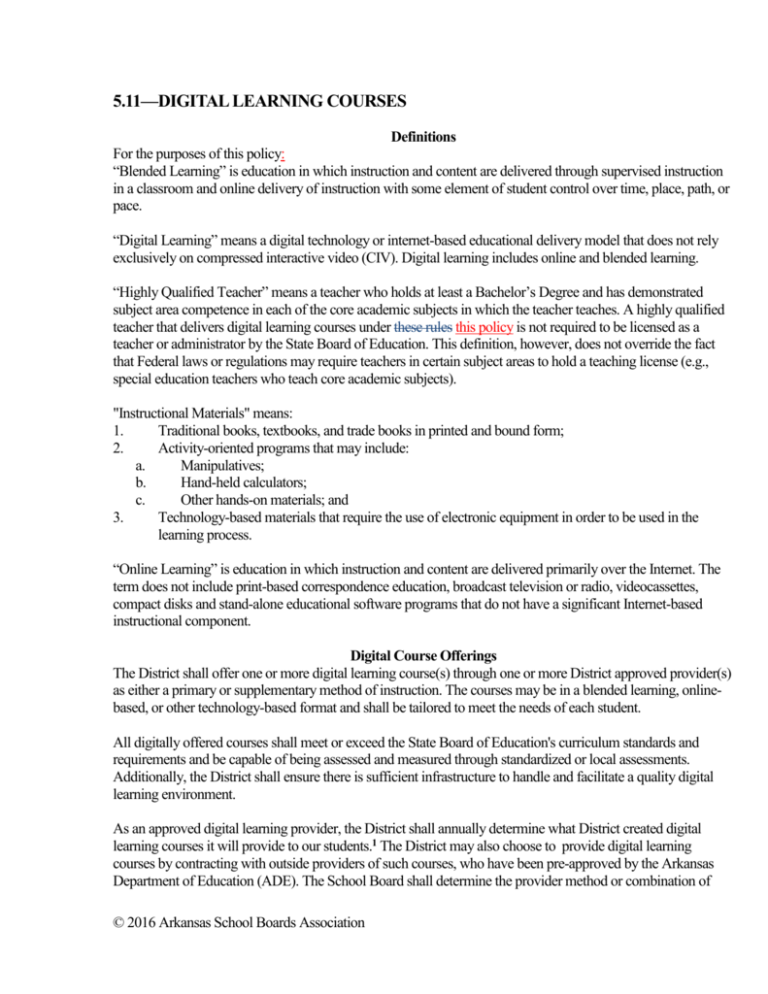
5.11—DIGITAL LEARNING COURSES Definitions For the purposes of this policy: “Blended Learning” is education in which instruction and content are delivered through supervised instruction in a classroom and online delivery of instruction with some element of student control over time, place, path, or pace. “Digital Learning” means a digital technology or internet-based educational delivery model that does not rely exclusively on compressed interactive video (CIV). Digital learning includes online and blended learning. “Highly Qualified Teacher” means a teacher who holds at least a Bachelor’s Degree and has demonstrated subject area competence in each of the core academic subjects in which the teacher teaches. A highly qualified teacher that delivers digital learning courses under these rules this policy is not required to be licensed as a teacher or administrator by the State Board of Education. This definition, however, does not override the fact that Federal laws or regulations may require teachers in certain subject areas to hold a teaching license (e.g., special education teachers who teach core academic subjects). "Instructional Materials" means: 1. Traditional books, textbooks, and trade books in printed and bound form; 2. Activity-oriented programs that may include: a. Manipulatives; b. Hand-held calculators; c. Other hands-on materials; and 3. Technology-based materials that require the use of electronic equipment in order to be used in the learning process. “Online Learning” is education in which instruction and content are delivered primarily over the Internet. The term does not include print-based correspondence education, broadcast television or radio, videocassettes, compact disks and stand-alone educational software programs that do not have a significant Internet-based instructional component. Digital Course Offerings The District shall offer one or more digital learning course(s) through one or more District approved provider(s) as either a primary or supplementary method of instruction. The courses may be in a blended learning, onlinebased, or other technology-based format and shall be tailored to meet the needs of each student. All digitally offered courses shall meet or exceed the State Board of Education's curriculum standards and requirements and be capable of being assessed and measured through standardized or local assessments. Additionally, the District shall ensure there is sufficient infrastructure to handle and facilitate a quality digital learning environment. As an approved digital learning provider, the District shall annually determine what District created digital learning courses it will provide to our students.1 The District may also choose to provide digital learning courses by contracting with outside providers of such courses, who have been pre-approved by the Arkansas Department of Education (ADE). The School Board shall determine the provider method or combination of © 2016 Arkansas School Boards Association methods for the District. The Superintendent shall ensure that all digital learning courses provided to District students, regardless of the source of the course, have been approved by ADE. District created digital courses and any digital courses the district purchases from outside providers shall adhere to the guidelines for the use of digitally transmitted copyrighted materials set forth in Policy 5.8—USE OF COPYRIGHTED MATERIALS as well as applicable statutory requirements. The District shall require all outside providers to incorporate Policy 5.8 as a condition of the service contract. Failure of the outside provider to abide by Policy 5.8 shall constitute a breach of contract and the outside provider shall be responsible for any costs resulting from such breach. Students may take ______ digital learning courses. Students must be physically present for _____each digital learning class he/she takes.2 The District is responsible for providing all instructional materials for each student who enrolls in a District approved digital learning course.3 Regardless of any other provisions of this policy, the District may restrict a student's access to digital courses when the student's school building principal determines the student’s participation in such a course would not be academically appropriate based on the student's past performance in digital courses. Furthermore, the student's school building principal may revoke a student's eligibility to continue taking a digital learning course if the student's performance during the semester indicates the student is not succeeding in the course.4 Notes: 1 The district is NOT required to provide its own digital learning courses, but doing so affords the most oversight of what content such courses contain and how the courses are taught. Note that should the district choose to offer digital courses to non-district students, the district will have to go through the same provider approval process as is required for all "outside" providers. 2 The statutes and Rules stipulate that the State Board of Education may not require the digital learning provider limit their delivery to districts that require a student's physical presence at a district school for successful completion of such a course nor place a limit on the number of digital learning courses a student may take for credit. While these limitations exist for the State Board, they do not exist for individual districts. There are MANY factors the school board may wish to consider when deciding whether to limit the number of such courses a student may take and/or how many of those will require the student's presence on campus and if so, for what percentage of the class time such presence is required. A partial listing of possible considerations include (It is not the intent of the list to sway a district's decision one way or another, but rather to help ensure that decisions are made after careful and deliberate consideration of the factors involved): 1. What are the effects on district staffing of digitally offering courses? 2. What does the definition of "Highly Qualified Teacher" do to your staffing needs? 3. What are the effects of using outside digital providers? How do these compare and relate to district provided courses? 4. What are the effects on district culture (staff, student, and parent) of "absentee" students and staff? © 2016 Arkansas School Boards Association 5. 6. 7. 8. 9. 10. 11. 12. What are the effects on student learning from digital courses? Do the possible effects change as the number of courses are offered within the district? What are the potential financial effects of digitally offering courses? How many students might you lose or gain due to digital course offerings? How many of these might presently be home schooled? What does a "presence required" decision make on recruiting home schooled students? What does digital learning do to your ability to pass a millage? What does digital learning do to your need to pass a millage? What are the effects on non-digitally offered courses due to the presence of digitally offered courses? Will you require "seat time" for each course or for any course? Can a student take an EOC at any time? How do your answers to question #10 affect your district's absentee policy? What does it do to your ADM and foundation funding? 3 This sentence is based on the statutory definition of "instructional materials" that is included in the policy. The statute further provides that the instructional materials shall be provided at no cost to students for all subjects taught. This fundamentally effects how you approach the logistics of providing digital learning courses. How a student accesses a course and the student's potential for success in the course can significantly change depending on where the student physically takes the course and the resources available for each student. If you allow students to not be present on campus to take a course, some students will have better access to resources than other students. The result can be less opportunity/options for some students than for others. While this may not be a legal liability issue, it certainly is a fairness issue. Is it fair to establish course offerings in a manner that allow some students to be successful while not having to physically attend school while others are less likely to be successful due to a lack of access if they don't attend on campus? 4 While digital learning offers great promise for engaging students, it also requires maturity and study skills that will not work for some students. The intention of the paragraph is to leave the initial digital enrollment open to previously poor and/or disengaged students who might thrive in a digital format, and yet still give the principal the authority to intervene when it's in the student's best interest. Cross References: 4.7—ABSENCES 4.45.1—SMART CORE CURRICULUM AND GRADUATION REQUIREMENTS FOR THE CLASS OF 2018 AND THEREAFTER 4.45.1—SMART CORE CURRICULUM AND GRADUATION REQUIREMENTS FOR THE CLASSES OF 2015, 2016, AND 2017 5.8—USE OF COPYRIGHTED MATERIALS Legal References: A.C.A. § 6-16-1401 et seq. ADE RULES GOVERNING THE DIGITAL LEARNING ACT OF 2013 Date Adopted: Last Revised: © 2016 Arkansas School Boards Association





